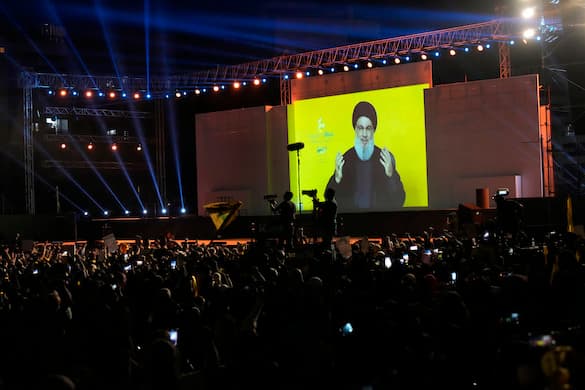A GoFundMe Page for Hezbollah? No, but Terrorist Group’s Bid for Donations Heightens Tensions Along Israel’s Northern Border
While all eyes are on Gaza, Israel’s border with Lebanon emerges as a flashpoint as war in the region lurches toward a hot summer.

There are hot messes and then there is Lebanon, which, largely thanks to decades of serial Iranian meddling, elevates (or lowers) political chaos to a whole new level. One case in point is Hezbollah, responsible for a long list of deadly cross-border attacks against northern Israel since the Hamas attack on southern Israel on October 7. The Tehran-backed Shia Muslim terrorist group’s vast arsenal of rockets is well known, but there are signs Hezbollah could be faltering on the financial front.
According to a pan-Arab newspaper, Asharq Al Awsat, Hezbollah has just launched a donation campaign aimed at coaxing Lebanese civilians to give money to buy more drones and missiles for the group to use against Israel. It was not immediately clear by what means the group has set about soliciting funds — a GoFundMe page seems unlikely — but Asharq reported that Hezbollah in Lebanon has been posting phone numbers for civilians to call so as to “be part of the battle” it is waging against Israel in support of Hamas terrorists in Gaza.
The question is, if Hezbollah is ostensibly so well-funded by the mullahs at Tehran, why does it need to harangue everyday Lebanese to pay for more weapons? A former Lebanese parliamentarian, Fares Souaid, told Asharq that Hezbollah is “indirectly declaring itself in a deep political and financial crisis, which indicates that Iran has taken a decision to stop funding (Hezbollah’s) war in south Lebanon.”
That could be more wishful thinking than reality. A report in a Kuwaiti newspaper, Al Jarida, appears to confirm that Hezbollah is indeed in possession of long-range precision missiles as well as anti-aircraft missiles made in Russian with modifications courtesy of Iran. The group’s firebrand leader, Hassan Nasrallah, reportedly said in 2022, “We have started manufacturing drones in Lebanon a long time ago. Those who want to buy can fill out an application.”
Drone arsenals notwithstanding, the crazed Shia terrorists are, according to the Kuwaiti report, probably already casing Israeli patrols along the border with a view toward planning ambushes and even carrying out operations on Israeli soil. Hezbollah’s losses have not been inconsequential, but are seen by the group’s top henchmen as manageable, at least so far.
The group’s escalatory maneuvers, made in perceived solidarity with a greatly diminished Hamas, have already resulted in widespread destruction in dozens of southern Lebanese villages following retaliatory strikes by Israel. In that strategic region as at Beirut, memories of the extensive material damage and suffering Mr. Nasrallah brought upon the Lebanese people by initiating a war with Israel in 2006 are still painfully fresh.
If right now the aging terror chief feels compelled to turn to already cash-strapped locals for financial support, it doesn’t in any way mean, though, that Hezbollah is a spent force. For one thing, thanks to its cross-border attacks, more than 60,000 Israelis cannot return to their homes in northern Israel.
Inside Lebanon, where Hezbollah is a major political as well as military force, other problems are brewing. Last month an official belonging to the Christian-based Lebanese Forces party, Pascal Sleiman, was assassinated — possibly as retaliation for the party’s criticism of Hezbollah’s attacks against Israel.
In the meantime, there are more than a million Syrians living in Lebanon, many of them refugees who fled Syria’s civil war starting in 2011. Anger over their lingering presence, and the drain on resources they purportedly represent, is rising.
The more damage Israel inflicts on southern Lebanese villages in response to aggression by Hezbollah, the fewer places there are for some Syrian refugees to go — that tension is a potential ingredient in another Lebanese civil war.
If that sounds far-fetched, it really isn’t. The country is an economic basket case: By most accounts the state can only supply six hours of electricity a day. For 18 months, it has not had a president.
This week the French special envoy to Lebanon, Jean-Yves Le Drian, met with the Lebanese parliament speaker, Nabih Berri, at Beirut, in a bid to defuse tensions and move the country past a crisis footing. Yet the political deadlock remains, and Paris only wishes it had the keys. Mr. Nasrallah and Tehran still call the shots in this fractured country; how much weary ordinary Lebanese citizens are willing to pony up to keep haranguing Israel remains to be seen.

